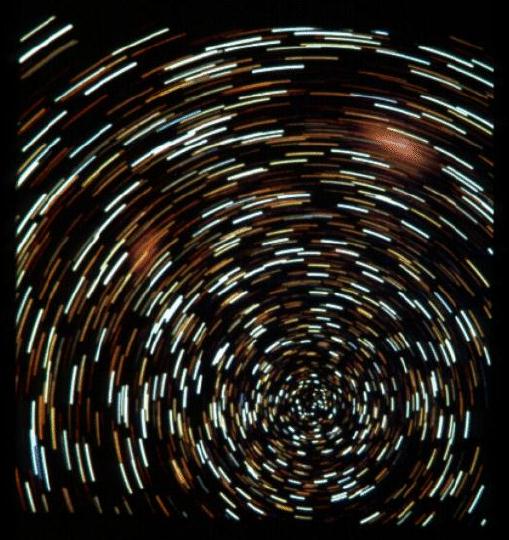|
|
 |
 |
 |
It was apparent to the ancients that the motions of some celestial bodies, although seemingly random and complicated, were actually quite simple and very regular. The relative positions of the visible (naked eye) stars do not change very quickly; the stars (and most other celestial bodies) moved in unison around the sky making one complete trip around the sky once every 23 hours 56 minutes and 4.091 seconds (the sidereal day). The stars rose over the eastern horizon and set over the western horizon (just as does the Sun). The stars circle about the point in the sky roughly where the North Star (Polaris ) currently resides. To aid in locating stars and objects in the sky, the ancients grouped stars together into familiar shapes, the constellations, (e.g., Orion).
There were also some objects that, in addition to their daily motions, also moved slowly against the backdrop of the stars. For example, the Sun and Moon were not stationary amongst the stars; they moved steadily in the west-to-east direction through the stars completing one trip around the stars in 365.256363004 days, the sidereal year , and 27.321661 days, the sidereal month, respectively. More inexplicable though, was the motion of the planets who also moved amongst the backdrop of stars but would reverse directions periodically. Planets usually move west-to-east through the stars as does the Sun, but they also reverse course at times to move east-to-west through the stars. They finally reverse again returning to moving west-to-east through the stars until they complete their trips through the stars. These backward excursions are known as retrograde motions. These irregular motions were perplexing to the ancients.
|
 |
Furthermore, among the most precise clocks that we have available to us on Earth are ones based on astronomical motions, e.g., the rate at which stars known as the millisecond pulsars rotate is very steady and a network of them could serve as a very high precision timepiece. For long times, millisecond pulsars may, in fact, be even more accurate than atomic clocks.
The development of modern science started when people tried to understand not the regularity of the motions of celestial bodies but, rather, when people tried to fathom the seemingly omnipotent motions and powers of the planets; an enterprise which took over 2,000 years. The effort culminated in the works of Tycho, Kepler, and Newton; Kepler proposed three laws of planetary motion (Topic 3) which described precisely the motions of the planets observed by Tycho, while Newton proposed a theory which gave a physical basis for Kepler's laws. Newton proposed: three laws of motion basically a set of rules which allows one to calculate how objects move when subjected to forces; and the Law of Universal Gravitation which described how the force of gravity worked.
When properly applied Newton's laws are very accurate and form the physics which governs the dynamics of most of our everyday experiences. Based on this work and his other contributions, Newton is arguably the greatest physicist who ever lived. However, we continue to learn about the dynamics (motions) of the planets even today. Applying the theories of Newton, a new discipline of physics has developed over the last twenty years, the study of nonlinear dynamics and, in particular, a phenomenon known as CHAOS. The characteristic of chaos which is of particular interest to us (in this course) is the extreme sensitivity of chaotic systems to small disturbances in their initial conditions.

